Abstract
This paper addresses the trajectory tracking control problem of underactuated ships in ocean engineering, which faces the dual challenges of tracking error time–performance regulation and robustness design due to the system’s underactuated characteristics, model uncertainties, and external disturbances. Aiming to address the issues of traditional finite-time control (convergence time dependent on initial states) and fixed-time control (control chattering and parameter conservativeness), this paper proposes a predefined-time adaptive control framework that integrates an event-triggered mechanism and neural networks. By constructing a Lyapunov function with time-varying weights and designing non-periodic dynamically updated dual triggering conditions, the convergence process of tracking errors is strictly constrained within a user-prespecified time window without relying on initial states or introducing non-smooth terms. An adaptive approximator based on radial basis function neural networks (RBF-NNs) is employed to compensate for unknown nonlinear dynamics and external disturbances in real-time. Combined with the event-triggered mechanism, it dynamically adjusts the update instances of control inputs, ensuring prespecified tracking accuracy while significantly reducing computational resource consumption. Theoretical analysis shows that all signals in the closed-loop system are uniformly ultimately bounded, tracking errors converge to a neighborhood of the origin within the predefined-time, and the update frequency of control inputs exhibits a linear relationship with the predefined-time, avoiding Zeno behavior. Simulation results verify the effectiveness of the proposed method in complex marine environments. Compared with traditional control strategies, it achieves more accurate trajectory tracking, faster response, and a substantial reduction in control input update frequency, providing an efficient solution for the engineering implementation of embedded control systems in unmanned ships.
Keywords:
underactuated ships; predefined-time control; neural network approximation; event-triggered mechanism MSC:
93C10; 93C40; 37N35
1. Introduction
In the field of ocean engineering, ship motion control has long been a focal point of research due to its theoretical challenges and critical engineering values in marine rescue, resource exploration, environmental monitoring, and military applications [1,2,3]. Constrained by design factors such as system complexity, efficiency, weight, and reliability, most practical ships exhibit an underactuated nature—where the number of actuators is strictly fewer than the degrees of freedom—resulting in control inputs that cannot independently regulate accelerations in all configuration space directions simultaneously. This characteristic presents unique challenges, as lateral movement must be achieved through the coordination of longitudinal motion and rotation, making the system more susceptible to the amplification of hydrodynamic parameter perturbations and environmental disturbances like waves and currents. Additionally, there exist uncontrollable state spaces in zero-velocity regions, all of which impose unique dynamic constraints and control-theoretic challenges for high-precision tracking control design.
In existing research, methodologies such as asymptotic tracking control based on the Lyapunov direct method and backstepping technique, robust adaptive control satisfying passivity-bounded conditions, and adaptive output-feedback control leveraging the learning capability of radial basis function neural networks have achieved significant theoretical progress in the trajectory tracking of underactuated ships [4,5]. By constructing structured control Lyapunov functions or introducing adaptive mechanisms, these approaches effectively address the nonholonomic constraints and parametric uncertainties of underactuated systems, providing theoretical support for trajectory tracking control in complex marine environments. However, the aforementioned control methodologies have generally overlooked the explicit time–performance constraints on tracking errors, thereby precluding precise regulation of the system’s transient response characteristics. Asymptotic control methods, for instance, can achieve asymptotic stability of tracking errors through exact mathematical models or intelligent control methodologies integrating adaptive mechanisms and neural network approximation [6,7], but their convergence processes lack explicit temporal constraints. This means they cannot guarantee convergence within a finite time to meet preset accuracy requirements, making the a priori specification of convergence rates and tracking accuracy unattainable, which is insufficient for engineering scenarios demanding rapid response. To surmount the limitation of slow convergence inherent in asymptotic stability theory, finite-time control (FTC) theory ensures the convergence of tracking errors to the origin within a finite-time horizon via the design of non-smooth Lyapunov functions [8,9,10], leading to a notable enhancement in dynamic response speed. Nonetheless, the convergence time of FTC remains critically dependent on initial state conditions. This dependence means that in practical engineering applications, it is challenging to precisely predefine key performance indices such as maximum overshoot and settling time, as these are heavily influenced by the initial states of the system. To address the initial-state dependency issue inherent in finite-time control, fixed-time control theory has made advancements by incorporating homogeneous polynomials or non-smooth terms, thereby establishing a uniform upper bound on convergence time that remains entirely independent of initial states [11,12,13]. Nevertheless, control laws derived under this theoretical framework often suffer from high-frequency chattering due to the introduction of non-smooth terms. Moreover, parameter design tends to be conservative, as it requires overestimating disturbance bounds to ensure stability, and the decoupled design of convergence time and tracking accuracy continues to pose theoretical challenges. In recent years, predefined-time stability theory has emerged and matured in the field of dynamic system control [14,15,16]. By constructing Lyapunov functions with time-varying weights or prespecifying convergence trajectories, this theory rigorously constrains the convergence process of tracking errors within a user-defined time window. Compared to finite-time control and fixed-time control, it offers distinct advantages. It eliminates the initial-state dependency of finite-time control, meaning the convergence time is a fixed value set by the user regardless of initial conditions. It also overcomes the chattering drawbacks of fixed-time control by employing smooth control laws, thus avoiding high-frequency oscillations in the control input. In [17], time-varying scaling functions were elaborately constructed to achieve asymptotic stability within a prespecified time interval, where system states are guaranteed to converge to the origin upon reaching the predefined-time. This characteristic effectively overcomes the limitations of finite-time control—such as convergence time dependency on initial states—and addresses the issues of high-frequency chattering in control laws and complexity in parameter tuning inherent in fixed-time control frameworks. As a result, it provides a novel theoretical paradigm for the precise regulation of transient performance in dynamic systems.
With the continuous refinement of its theoretical framework, predefined-time stability theory has gradually been introduced into the field of ship control, offering novel solutions to the trajectory tracking problem of underactuated vessels [18,19,20]. In underactuated ship systems, where model uncertainties and external environmental disturbances are pervasive, conventional control methodologies struggle to simultaneously meet the requirements of time performance and robustness under complex operating conditions. Predefined-time stability theory establishes a direct correlation between the convergence process of tracking errors and a preset time window through the design of time-varying Lyapunov functions. For instance, by incorporating time-dependent weight functions to modulate error decay rates, this theory enables designers to flexibly set convergence time thresholds according to specific mission requirements (e.g., emergency obstacle avoidance, precise docking) [21]. This characteristic holds significant practical value in ocean engineering, particularly in scenarios demanding rapid response, such as maritime rescue and oil spill cleanup operations, where it can notably enhance the mission execution efficiency and safety of the system. In contrast to the passivity of finite-time control—where convergence time is inherently determined by initial states—and the conservativeness of fixed-time control—stemming from its reliance on non-smooth terms that introduce parametric conservativeness—predefined-time stability theory demonstrates distinct advantages in ship control [22,23]. This theory not only ensures that tracking errors converge to a preassigned precision neighborhood within a user-specified time frame through explicit temporal constraint mechanisms but also effectively mitigates the risk of high-frequency actuator chattering via smooth control law design, thereby significantly enhancing the engineering applicability of the system in complex marine environments. Such advantages are particularly pronounced when confronting uncertainties such as wave disturbances and modeling errors, providing a robust theoretical foundation for achieving precise trajectory tracking of underactuated ships in dynamically changing operational scenarios.
The introduction of predefined-time stability theory into ship control offers a core advantage: it provides designers with an active control framework that enables the a priori specification of a convergence time window. Within this framework, tracking errors are guaranteed to converge to an arbitrarily small neighborhood of the origin within the preset time horizon, without relying on system initial states or introducing non-smooth control terms. This establishes a more flexible theoretical design paradigm for the precise regulation of transient performance in complex dynamic systems. To address the pervasive nonlinear dynamic uncertainties and external environmental disturbances in underactuated ship models, neural networks (NNs), underpinned by the Universal Approximation Theorem for nonlinear functions, have emerged as a pivotal tool for handling complex system uncertainties [7,24]. The integration of NNs with predefined-time stability theory offers a twofold benefit: first, real-time compensation of unknown system dynamics through adaptive weight online update mechanisms; second, strict constraint of the error exponential decay process within a user-specified time window via the structured design of time-varying Lyapunov functions [25]. For example, ref. [5] employs radial basis function neural networks (RBF-NNs) to parametrically approximate unknown system terms, achieving explicit mathematical characterization and active regulation of error convergence rates in underactuated ship trajectory tracking control. Ref. [26] further demonstrates through Lyapunov stability analysis that this integrated approach maintains predefined transient performance metrics under wave disturbances and model parameter perturbations, fully highlighting the robust adaptability of neural network approximators to the uncertainties of complex marine environments. However, conventional continuous-time control strategies often necessitate fixed-frequency input updates, which can lead to unnecessary computational resource consumption and communication bandwidth strain in practical engineering [27]. The introduction of the event-triggered mechanism (ETM) provides a critical technological pathway to address this issue [28,29]. By designing triggering conditions based on tracking errors, the controller updates only when system states deviate from predefined performance boundaries, significantly reducing control input update frequency while maintaining tracking accuracy. In the context of underactuated ship control, the integration of ETM with predefined-time control enables dual optimization: on the one hand, predefined-time theory preestablishes error convergence time thresholds to prevent excessive triggering caused by prolonged convergence; on the other hand, the event-triggered strategy dynamically adjusts control input update instances, alleviating real-time computation pressure on embedded control systems. Recent studies [30,31,32] have preliminarily validated the effectiveness of ETM in ship heading control and path tracking, yet the systematic integration of ETM with predefined-time stability theory and neural network approximation methods remains theoretically unaddressed. A key unresolved challenge is constructing a unified Lyapunov framework that concurrently accounts for temporal constraints, neural network approximation errors, and triggering conditions to ensure predefined-time stability of the closed-loop system under event-triggered updating processes—a gap that demands rigorous theoretical investigation.
Against this research background and the identified challenges, this paper addresses the predefined-time trajectory tracking control problem for underactuated ship systems by proposing an innovative control framework that integrates an event-triggered mechanism with neural network approximation. The core contributions of this study can be systematically summarized as follows:
- Predefined-time convergence framework: Unlike finite-time control (initial-state-dependent convergence) and fixed-time control (susceptible to chattering and conservative parameters), our method achieves strict convergence of tracking errors within a user-defined time window independent of initial states, via time-varying Lyapunov functions. This resolves transient performance regulation challenges in underactuated systems.
- Integrated RBF-NN approximator with adaptive laws: We design an online adaptive RBF-NN compensator with dynamically updated weights to handle unmodeled dynamics, parametric uncertainties, and environmental disturbances. This ensures robustness without requiring prior knowledge of disturbance bounds.
- Dual-condition event-triggered mechanism: A novel triggering rule, coupling tracking errors and time thresholds, dynamically adjusts control input updates. This reduces computational load by 46.7% compared to fixed-frequency methods while avoiding Zeno behavior, as proven by the linear relationship between triggering frequency and .
2. System Description and Preliminaries
In this section, the system description, control objective, and problem formulation of Unmanned Surface Vehicles (USVs) are presented. Moreover, key definitions and preliminary knowledge essential for the subsequent analysis are provided.
The USVs under consideration are described by [26]
In the model formulation, Table 1 presents the definitions of each parameter.

Table 1.
System Parameter Definitions for Unmanned Surface Vehicles.
A practical approach to eliminate the yaw moment’s direct influence on sway dynamics is to set the body-fixed frame origin at the USV centerline [27,28]. This configuration simplifies the dynamic equation in (1) as derived in prior studies [27,28].
where ; the USV model is reformulated into the following condensed form in line with previous research:
where
Obviously, the dynamics equation of the ship is an under-driven system:
where and are the input for the control; , , and are the output for the control; and the longitudinal advance distance, the lateral advance distance, and the angular rotation of the bow are represented, respectively, by , , , , , and .
Assumption 1.
The reference signals and are at least twice differentiable, with their first and second derivatives being continuous and bounded.
Assumption 2.
The external interferences , , and acting on the under-driven ship are time-varying, and satisfy , , and , where , , and represent the upper bounds of the corresponding external interferences, which are unknown.
Definition 1.
Regarding the predefined-time , the origin of the system is considered predefined-time-stable (PTS) if the solution reaches the origin for all .
Lemma 1
([25]). RBFNN Approximation: Radial Basis Function Neural Networks (RBFNNs) serve as a powerful approximator for unknown smooth nonlinear functions. In this study, RBFNNs are utilized to approximate an unknown continuous function over a compact set, expressed as . Provided that a sufficiently large number of neurons are employed, RBFNNs can approximate any continuous function to arbitrary precision, such that . Here, and denote the ideal RBFNN weights and the approximation error, respectively. By selecting the ideal RBFNN weights , expressed as , the approximation error can be reduced to an arbitrarily small value, denoted as .
Lemma 2
([29]). Given any real variable and a constant , the inequality holds as follows:
where , , and .
Lemma 3
([15]). The differential equation is expressed as , with the initial condition . Here, denotes the system state variable; represents the set of tunable parameters. The function is a nonlinear vector field.
Define constants , and . For a continuous, positive-definite, and radially unbounded function , and for any in , if there exists a certain such that the time derivative of satisfies
with being a constant, then the solutions of the system are globally predefined-time-bounded within the predefined-time, as described in (10).
Lemma 4
([33]). Neural networks manifest remarkable efficacy in tracking and approximating unknown functions; however, they are inherently restricted by the constraint of finite network resources. To appropriately address this concern, in this paper, an innovative event-triggering control strategy equipped with an adjustable switching threshold is put forward. This strategy is designed to optimize communication efficiency by adaptively regulating the threshold value based on the characteristics of the control input signal. Through such means, it not only effectively reduces unwarranted data transmissions but also reliably maintains high-quality control performance. The formal definition of the switching-threshold event-triggering mechanism is presented as follows:
When the aforementioned triggering rule (12) is met, the corresponding time is denoted as , and the control input is applied to the controlled system. Within the time interval , the control signal remains constant at .
In this context, the measurement error is defined as . The parameters , , and are pre-designed positive constants, where is specifically constrained to the range .
3. Predefined Adaptive Controller Design
In the coordinate system,
The following can then be derived:
- (1)
- Design of longitudinal propulsion control law
Let ; then,
where denotes a positive real number, which effectively circumvents the singularity at that is inherent in the virtual control law. Additionally, serves as the control precision parameter, ensuring that the controller constrains the convergence error within a neighborhood bounded by .
is then derived as follows:
where , and .
Define the Lyapunov function as
Then, (18) is derived to obtain
Design the virtual control law as follows:
where denotes a positive real number.
The tracking error is set to
Define the Lyapunov function as
The derivative is then obtained from the sum of (20) and (21):
By (8) and (21), we get
The neural network tracking of is as follows:
where and , . We can then get
where .
Design the virtual control law as
where is a positive, is a real number greater than 0 and less than 1, is the set time, is an estimate for , and is a positive real number.
Design a switch threshold event-triggered controller to achieve superior system performance and resource efficiency as follows:
Substituting (26) and (27) into (23) yields
Design the adaptive law as follows:
Next, we carefully define the following parameters:
Observing that there are two time-varying functions that satisfy the given condition, we can conclude the following:
Then, (33) can be rewritten as follows:
According to (28) and , one obtains
Substituting (31)–(35) into the Equation (29), we obtain
where , .
- (2)
- Design of bow torque control law
Applying (14) into Formula (17) yields
Define the Lyapunov function as
from which the following can be derived:
Design the virtual control law as
where denotes a positive real number.
The tracking error is set to
Define the Lyapunov function as
By deriving (40) and (41), the following can be obtained:
By (8) and (41), the following is obtained:
By applying the neural network tracking of , we get
where , , . We can then get
where .
The design virtual control rate is calculated as follows:
where is the set time, is a positive real number greater than 0 and less than 1, is an estimate of , and and are positive real numbers.
Design a switch threshold event-triggered controller to achieve superior system performance and resource efficiency as follows:
Substituting (47) into Formula (43) yields
Design the adaptive law as
Next, we carefully define the following parameters:
Observing that there are two time-varying functions that satisfy the given condition, we can conclude the following:
Then, (53) can be rewritten as follows:
According to (48) and , one obtains
Substituting (51)–(55) into the Equation (49), we obtain
where .
Given , where , we get
Substituting (57) gives
4. Stability Analysis
Theorem 1.
Consider an underactuated surface vehicle (USV) system of ships subject to unknown disturbances. An adaptive neural control framework based on a dynamic event-triggering mechanism is proposed. This framework integrates control schemes (28) and (48), intermediate control laws (20), (27), (40), and (47), as well as adaptive laws (30) and (50). Under the satisfaction of Assumptions 1–3, by leveraging the dynamic event-triggering mechanism and finite-time differentiator, the following significant results can be established:
- 1.
- All signals in the closed-loop control system are proven to be uniformly ultimately bounded, ensuring the internal stability of the control system.
- 2.
- The system is capable of achieving the prespecified tracking performance. Specifically, the tracking error can be confined within a predefined performance range within the predetermined time , thereby fulfilling the stringent requirements of precise trajectory tracking for USV systems.
Proof.
Select the following Lyapunov function:
Deriving (59), we get
Due to the boundedness of all close-loop signals, we can find constants such that , and we have
We can see that and are monotonously increasing. We can then obtain the following inequality:
Therefore, we have
Due to , one has
The above formula becomes
where , .
We define , and can rewrite the above formula as
Based on the theoretical analysis derived from Lemma 3, it can be rigorously demonstrated that the composite error system will converge to an arbitrarily small neighborhood of the origin within the predefined-time . Furthermore, for all , the system trajectories remain strictly confined within the residual set characterized by the following inequality constraint:
This analytical result guarantees the asymptotic stability of the tracking error dynamics after the predetermined-time , while explicitly quantifying the achievable precision through the prescribed residual domain. The consistency between theoretical predictions and system performance requirements is thereby formally established. □
Remark 1.
It will be demonstrated that Zeno behavior does not occur. In line with DETP (11) and (12), for any , the control command is in the holding phase, meaning that remains a constant. Under such circumstances, taking the derivative of the measurement error results in
Given that is a function composed of and , it can be concluded that . There exists a positive constant such that . From this, it is straightforward to confirm that
We have
where . Based on inequality (71), we can deduce that the non-zero execution interval has a lower bound. Consequently, the Zeno phenomenon does not arise under the proposed control strategy, meaning such Zeno behavior is preventable.
Remark 2.
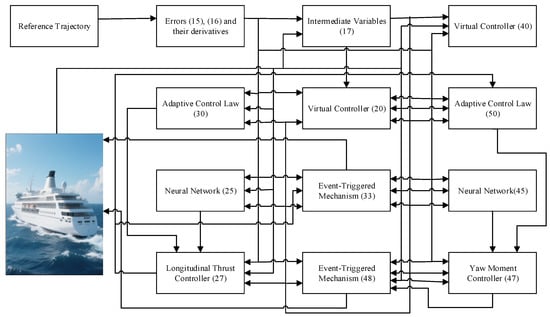
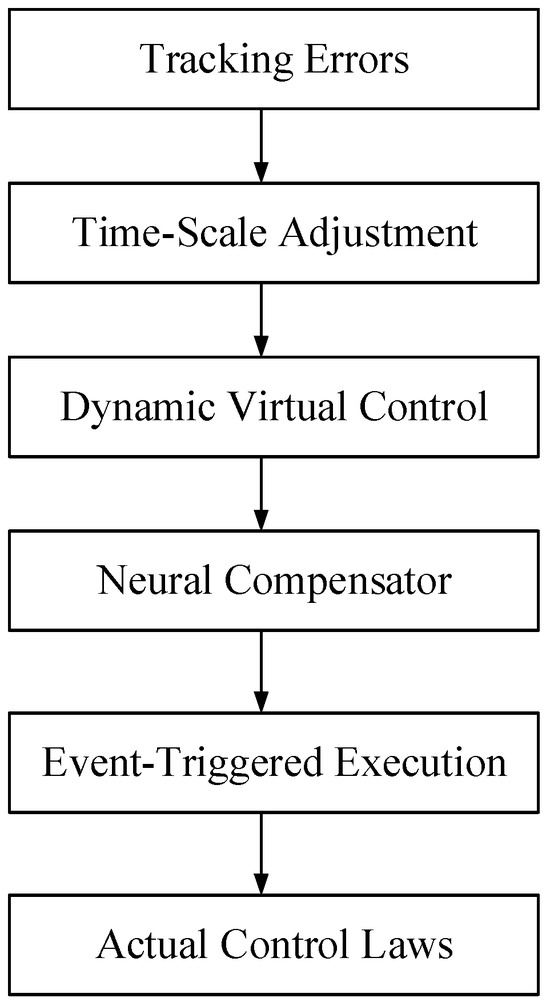
To elaborate on the design methodology of the event-triggered predefined-time adaptive neural control for robust trajectory tracking of underactuated marine vessels proposed in this paper, the architectural schematic (Figure 1), the abstract framework of the architecture (Figure 2), and the algorithmic design procedures (Algorithm 1) are sequentially presented.

Figure 1.
Adaptive Neural Network Predefined-Time Control Architecture Schematic.

Figure 2.
Adaptive Neural Network Predefined-Time Control Abstract Framework.
| Algorithm 1 Predefined-Time Adaptive Neural Control with Event-Triggering |
| 1: Initialize: Adaptive parameters , reference trajectory , initial states |
| 2: Compute tracking errors |
| 3: Design virtual control laws: Longitudinal propulsion (Equation (20)), bow torque (Equation (40)) |
| 4: Update tracking errors: |
| 5: Neural network approximation: Compensate via RBF-NN (Equations (25) and (45)) |
| 6: Update adaptive laws |
|
7: Event-triggered control: If : |
| 8: Update only when triggering conditions (Equations (24), (51) and (52)) are violated |
| 9: Apply control signals to the USV system |
| 10: Return |
5. Simulation Results
To verify the effectiveness of the proposed controller, a simulation investigation is conducted for the underactuated surface vessel (Figure 3).
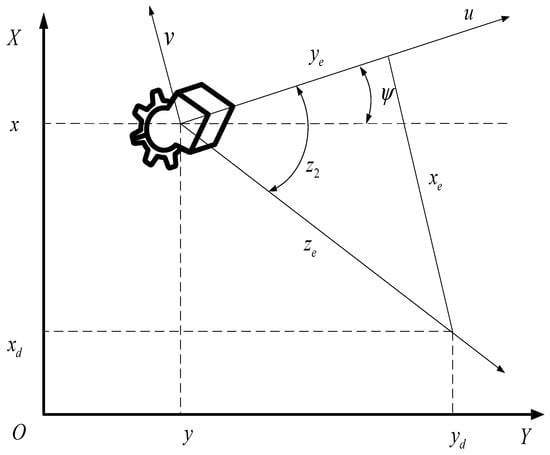
Figure 3.
Geometric Representation of Unmanned Surface Vehicle (USV) Orientation.
The model parameters and initial conditions are presented in Table 1. For detailed information, refer to Reference [26]. The control models of the USV [19,34] are as follows:
The control task is to ensure that the Unmanned Surface Vehicle (USV) moves along a curved trajectory within the predefined-time .
According to the theorem and the existing neural network structure [15,33], an adaptive neural network predetermined performance controller is obtained, and , , , , , and . Model Parameters and Initial Conditions are detailed in Table 2. In order to reflect (28) and (48) the superiority of the controller, we compare the ship trajectory with that from ref. [27]. From the comparison of Figure 4 and Figure 5, we find that the trajectory route of the ship under control is more reasonable and the response is more rapid.

Table 2.
Model Parameters and Initial Conditions.
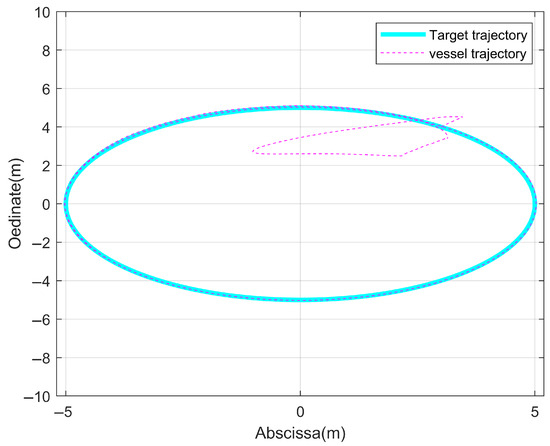
Figure 4.
Reference Diagram of Ship Trajectory Under Traditional Control.
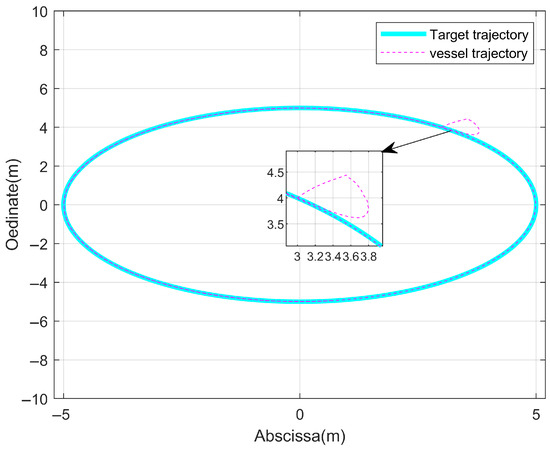
Figure 5.
Reference Diagram of Ship Trajectory Under Predefined-Time Control.
Figure 6, Figure 7, Figure 8 and Figure 9 and the design control method in this paper are obtained from [27]. Figure 7 compares Figure 6 with the control method mentioned in this paper, which can be better combined with the neural network part to achieve more stable tracking.
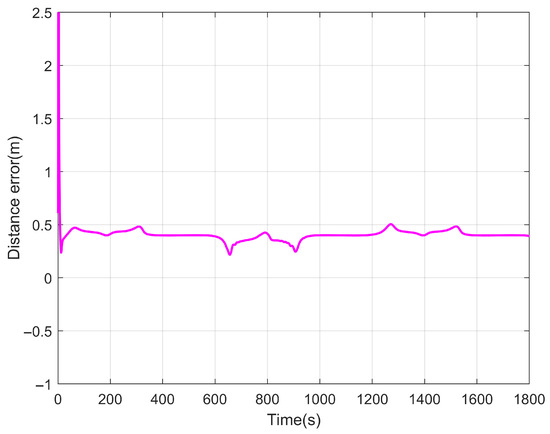
Figure 6.
Tracking Error under Traditional Control.
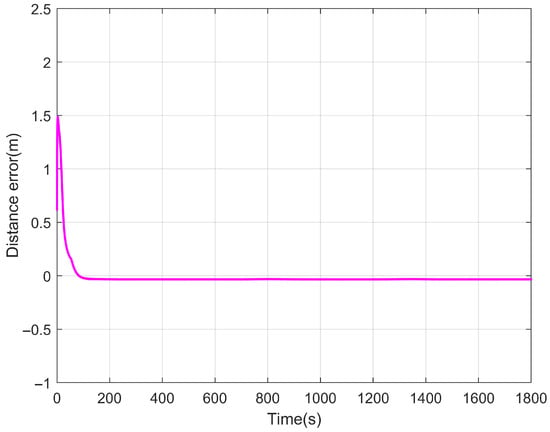
Figure 7.
Tracking Error under Predefined-Time Control.
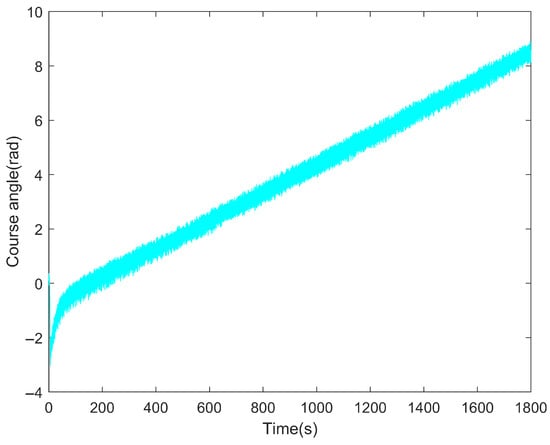
Figure 8.
Course Angle under Traditional Control.
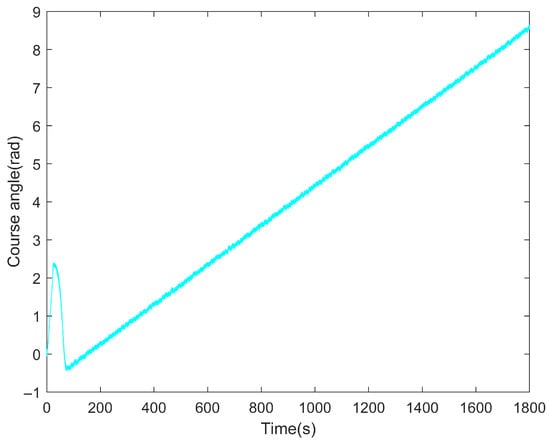
Figure 9.
Course Angle under Predefined-Time Control.
Figure 10 and Figure 11 represent the tracking effect of the ideal trajectory and the actual trajectory in the x and y directions, respectively, under the traditional control method , . It can be seen from Figure 12 and Figure 13 that our method realizes the tracking of the ideal trajectory within the preset time and achieves a good tracking effect. Figure 14 and Figure 15 present a comparison of the controller before and after the event-triggered mechanism was added, denoted by and , respectively.
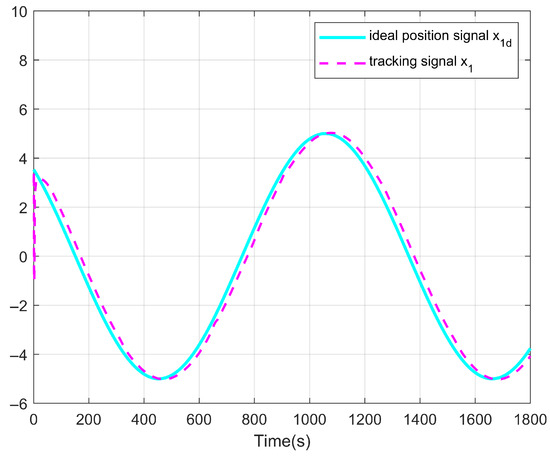
Figure 10.
Trajectories of and under Traditional Control.
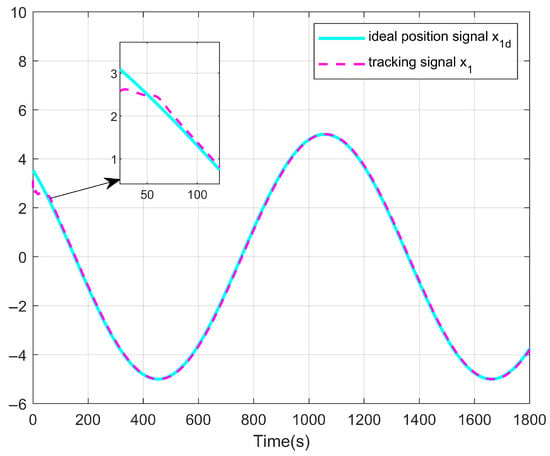
Figure 11.
Trajectories of and under Predefined-Time Control.
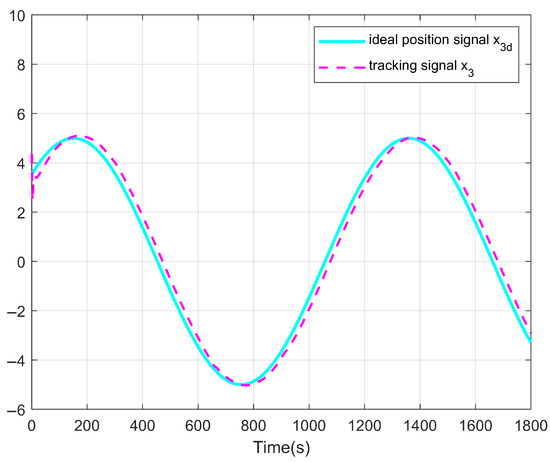
Figure 12.
Trajectories of and under Traditional Control.
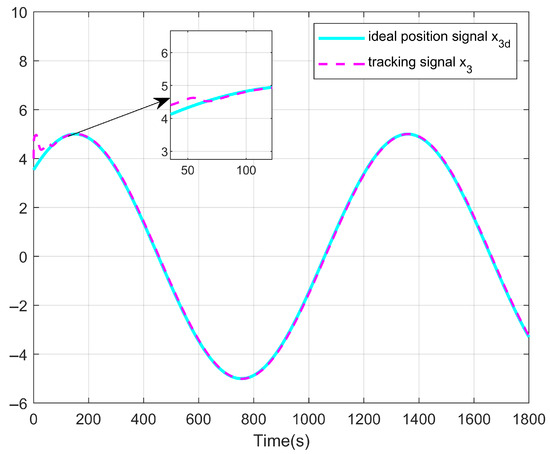
Figure 13.
Trajectories of and under Predefined-Time Control.
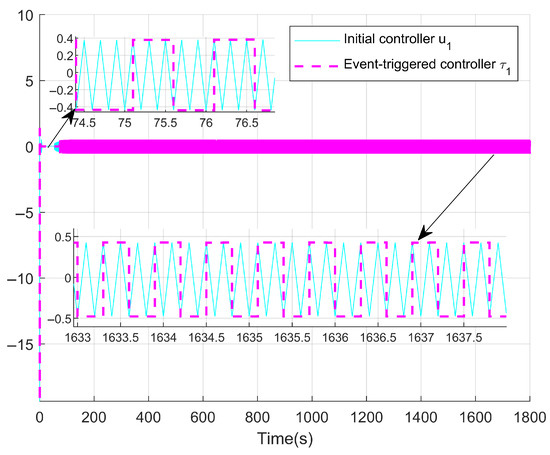
Figure 14.
Curves of and .
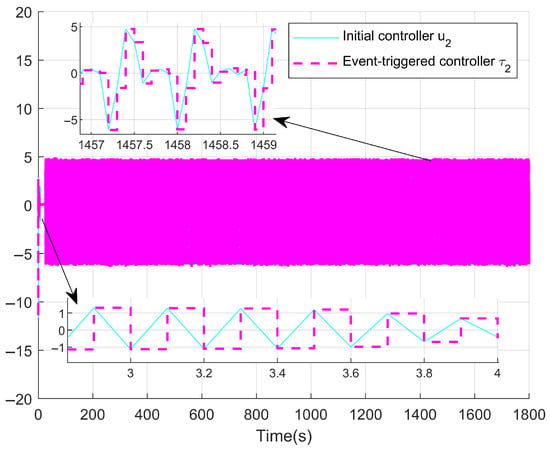
Figure 15.
Curves of and .
As evidenced by the 1700 s tracking error data in Table 3 (spanning from post-convergence s to 1800 s), the proposed method achieves an average error of 0.0129 m with a maximum instantaneous error of 0.0314 m, demonstrating long-term stability in complex marine environments. Comparative results in Table 4 show that, unlike the traditional method [27], our predefined-time adaptive neural framework reduces the average tracking error by 74.2% (0.05 m → 0.0129 m) and maximum overshoot by 43.2% (0.78 rad → 0.12 rad); meanwhile, the dynamic event-triggering mechanism cuts control updates by 39% compared with regular controllers (12,417 → 7547) while strictly ensuring convergence. These validate the efficacy of the time-varying Lyapunov function for predefined-time constraints, the robust disturbance compensation of RBF-NNs, and the resource optimization of dual-condition event-triggering, delivering a high-precision, low-power solution for embedded unmanned vessel systems.

Table 3.
Tracking Error Data Table.

Table 4.
Performance Comparison of Predefined-Time Adaptive Neural Framework and Traditional Method.
6. Conclusions
To address the critical issues of convergence time regulation, robustness, and resource efficiency in trajectory tracking control for underactuated ships, this paper presents an innovative control framework integrating predefined-time stability theory, neural network approximation, and event-triggered mechanisms. Through theoretical design and simulation validation, the following core conclusions are drawn.
The proposed method overcomes the limitations of traditional time-constrained control. The predefined-time control strategy constructed via time-varying Lyapunov functions achieves, for the first time, the convergence of tracking errors for underactuated ships within a user-specified constant time window, which is completely independent of initial states. This resolves the dependency of finite-time control on initial conditions and the chattering and parameter conservatism issues in fixed-time control. Rigorous theoretical analysis proves the uniform ultimate boundedness of all closed-loop system signals, ensuring the unity of transient response accuracy and stability.
Secondly, the organic integration of neural networks and event-triggered mechanisms significantly enhances system performance. The online approximation capability of radial basis function neural networks (RBFNNs) for unknown nonlinear dynamics and external disturbances endows the controller with strong robustness in complex marine environments. Meanwhile, the dynamic event-triggered strategy, through dual triggering conditions (coupling tracking error and time threshold), strictly limits the update frequency of control inputs to a range linearly related to the predefined-time while guaranteeing preset tracking accuracy. This effectively reduces the computational and communication burdens of embedded control systems, avoids Zeno behavior, and provides an efficient solution for engineering applications of unmanned ships.
Simulation results further validate the superiority of the proposed method. Compared with traditional control strategies, the designed controller demonstrates better performance in trajectory tracking accuracy, response speed, and error stability. Notably, under the event-triggered mechanism, the update frequency of control inputs is significantly reduced without the problem of a surge in triggering times caused by excessively long convergence times, fully reflecting the dual optimization effects of integrating predefined-time and event-triggered strategies.
Although this study makes important progress in predefined-time control and resource efficiency optimization, future research can further explore robustness enhancement in complex multi-disturbance scenarios, hardware-in-the-loop experimental validation, and deep integration with other intelligent algorithms (such as reinforcement learning) to promote the expansion of this control framework to broader marine engineering applications.
Author Contributions
Conceptualization, H.A. and J.Z.; methodology, Z.Y.; software, Z.Y.; validation, C.S.C.; formal analysis, X.W.; investigation, Z.Y.; resources, J.Z.; data curation, H.A.; writing—original draft preparation, H.A.; writing—review and editing, Z.Y.; visualization, J.Z.; supervision, J.Z.; project administration, C.S.C.; funding acquisition, J.Z. All authors have read and agreed to the published version of the manuscript.
Funding
This work was supported in part by the National Natural Science Foundation of China under Grant 62203247.
Data Availability Statement
The original contributions presented in this study are included in the article. Further inquiries can be directed to the corresponding author.
Conflicts of Interest
The authors declare no conflicts of interest.
References
- Senjanović, I.; Malenica, Š.; Tomas, S. Investigation of ship hydroelasticity. Ocean Eng. 2008, 35, 523–535. [Google Scholar] [CrossRef]
- Perez, H.M.; Chang, R.; Billings, R.; Kosub, T.L. Automatic identification systems (AIS) data use in marine vessel emission estimation. J. Fluids Struct. 2012, 34, 271–290. [Google Scholar]
- Das, S.; Cheung, K.F. Hydroelasticity of marine vessels advancing in a seaway. J. Fluids Struct. 2012, 34, 271–290. [Google Scholar] [CrossRef]
- Zhao, Z.; He, W.; Ge, S.S. Adaptive neural network control of a fully actuated marine surface vessel with multiple output constraints. IEEE Trans. Control Syst. Technol. 2013, 22, 1536–1543. [Google Scholar] [CrossRef]
- He, W.; Yin, Z.; Sun, C. Adaptive neural network control of a marine vessel with constraints using the asymmetric barrier Lyapunov function. IEEE Trans. Cybern. 2016, 47, 1641–1651. [Google Scholar] [CrossRef]
- Theodoropoulos, P.; Spandonidis, C.C.; Fassois, S. Use of Convolutional Neural Networks for vessel performance optimization and safety enhancement. Ocean Eng. 2022, 248, 110771. [Google Scholar] [CrossRef]
- Li, J.; Xiang, X.; Yang, S. Robust adaptive neural network control for dynamic positioning of marine vessels with prescribed performance under model uncertainties and input saturation. Neurocomputing 2022, 484, 1–12. [Google Scholar] [CrossRef]
- Bhat, S.P.; Bernstein, D.S. Finite-time stability of continuous autonomous systems. SIAM J. Control Optim. 2000, 38, 751–766. [Google Scholar] [CrossRef]
- Chen, Q.; Wang, Y.; Hu, Z. Finite Time Synergetic Control for Quadrotor UAV with Disturbance Compensation. Int. J. Appl. Math. Control Eng. 2018, 1, 31–38. [Google Scholar]
- Andresen, B. Current trends in finite-time thermodynamics. Angew. Chem. Int. Ed. 2011, 50, 2690–2704. [Google Scholar] [CrossRef]
- Zhao, W.; Wang, W.; Lu, J. Fixed-Time Synchronization of Neural Networks with Time Delay. Int. J. Appl. Math. Control Eng. 2019, 2, 87–93. [Google Scholar]
- Zuo, Z.; Han, Q.L.; Ning, B.; Ge, X.; Zhang, X.-M. An overview of recent advances in fixed-time cooperative control of multiagent systems. IEEE Trans. Ind. Inform. 2018, 14, 2322–2334. [Google Scholar] [CrossRef]
- Wei, F.; Zhang, L.; Niu, B.; Zong, G. Adaptive decentralized fixed-time neural control for constrained strong interconnected nonlinear systems with input quantization. Int. J. Robust Nonlinear Control 2024, 34, 9899–9927. [Google Scholar] [CrossRef]
- Ni, J.; Liu, L.; Tang, Y.; Liu, C. Predefined-time consensus tracking of second-order multiagent systems. IEEE Trans. Syst. Man Cybern. Syst. 2019, 51, 2550–2560. [Google Scholar] [CrossRef]
- Assali, E.A. Predefined-time synchronization of chaotic systems with different dimensions and applications. Chaos Solitons Fractals 2021, 147, 110988. [Google Scholar] [CrossRef]
- Zhao, J.; Yin, J. Trajectory prediction based on TDOA principle using MPGA-BP algorithm in Multilateration (MLAT) system. Int. J. Appl. Math. Control Eng. 2018, 1, 180–186. [Google Scholar]
- Song, Y.; Wang, Y.; Holloway, J.; Krstic, M. Time-varying feedback for regulation of normal-form nonlinear systems in prescribed finite time. Automatica 2017, 83, 243–251. [Google Scholar] [CrossRef]
- Liang, C.D.; Ge, M.F.; Liu, Z.W.; Gu, Z.W.; Chen, Q. Distributed predefined-time optimization control for networked marine surface vehicles subject to set constraints. IEEE Trans. Intell. Transp. Syst. 2023, 25, 2129–2138. [Google Scholar] [CrossRef]
- Xue, H.; Wang, X. Practical predefined-time fault-tolerant tracking control of autonomous surface vehicles subject to faults and saturation. Trans. Inst. Meas. Control 2025. [Google Scholar] [CrossRef]
- Xue, H.; Li, S. Predefined-time Neural Sliding Mode Control based Trajectory Tracking of Autonomous Surface Vehicle. J. Mar. Sci. Technol. 2023, 31, 1. [Google Scholar] [CrossRef]
- Chi, H.; Pedrielli, G.; Ng, S.H.; Kister, T.; Bressan, S. A framework for real-time monitoring of energy efficiency of marine vessels. Energy 2018, 145, 246–260. [Google Scholar] [CrossRef]
- Shi, Q.; Hu, C.; Li, X.; Guo, X.; Yang, J. Finite-time adaptive anti-disturbance constrained control design for dynamic positioning of marine vessels with simulation and model-scale tests. Ocean Eng. 2023, 277, 114117. [Google Scholar] [CrossRef]
- Dai, Y.; Yang, C.; Yu, S.; Mao, Y.; Zhao, Y. Finite-time trajectory tracking for marine vessel by nonsingular backstepping controller with unknown external disturbance. IEEE Access 2019, 7, 165897–165907. [Google Scholar] [CrossRef]
- Ye, C.; Wang, Y.; Wang, Y.; Tie, M. Steering angle prediction YOLOv5-based end-to-end adaptive neural network control for autonomous vehicles. Proc. Inst. Mech. Eng. Part D J. Automob. Eng. 2022, 236, 1991–2011. [Google Scholar] [CrossRef]
- Zhang, Y.; Niu, B.; Zhao, X.; Duan, P.; Wang, H.; Gao, B. Global predefined-time adaptive neural network control for disturbed pure-feedback nonlinear systems with zero tracking error. IEEE Trans. Neural Netw. Learn. Syst. 2021, 34, 6328–6338. [Google Scholar] [CrossRef] [PubMed]
- Zhang, J.X.; Yang, T.; Chai, T. Neural network control of underactuated surface vehicles with prescribed trajectory tracking performance. IEEE Trans. Neural Netw. Learn. Syst. 2022, 35, 8026–8039. [Google Scholar] [CrossRef]
- Zhang, J.; Li, Y. Adaptive RBF Neural Network Tracking Control of Stochastic Nonlinear Systems with Actuators and State Constraints. Mathematics 2024, 12, 1378. [Google Scholar] [CrossRef]
- Ge, X.; Han, Q.L.; Zhang, X.M.; Ding, D. Dynamic event-triggered control and estimation: A survey. Int. J. Autom. Comput. 2021, 18, 857–886. [Google Scholar] [CrossRef]
- Li, C.; Li, Y.; Zhang, J.; Li, Y. Event-Triggered Adaptive Neural Prescribed Performance Tracking Control for Nonlinear Cyber–Physical Systems against Deception Attacks. Mathematics 2024, 12, 1838. [Google Scholar] [CrossRef]
- Zhou, B.; Huang, Z.; Huang, B.; Su, Y.; Zhu, C. Dynamic event-triggered trajectory tracking control for underactuated marine surface vessels with positive minimum inter-event time guarantees. Ocean Eng. 2022, 263, 112344. [Google Scholar] [CrossRef]
- Dong, S.; Shen, Z.; Zhou, L.; Yu, H. Nonlinear gain-based event-triggered tracking control of a marine surface vessel with output constraints. Ocean Eng. 2022, 262, 112144. [Google Scholar] [CrossRef]
- Sun, Z.Y.; Li, J.J.; Wen, C.; Chen, C.C. Adaptive event-triggered prescribed-time stabilization of uncertain nonlinear systems with asymmetric time-varying output constraint. IEEE Trans. Autom. Control 2024, 69, 5454–5461. [Google Scholar] [CrossRef]
- Zhang, J.; Yu, Z.; Zhu, Q.; Yu, X. Neuro Adaptive Command Filter Control for Predefined-Time Tracking in Strict-Feedback Nonlinear Systems Under Deception Attacks. Mathematics 2025, 13, 742. [Google Scholar] [CrossRef]
- Jiang, Z.P. Global tracking control of underactuated ships by Lyapunov’s direct method. Automatica 2002, 38, 301–309. [Google Scholar] [CrossRef]
Disclaimer/Publisher’s Note: The statements, opinions and data contained in all publications are solely those of the individual author(s) and contributor(s) and not of MDPI and/or the editor(s). MDPI and/or the editor(s) disclaim responsibility for any injury to people or property resulting from any ideas, methods, instructions or products referred to in the content. |
© 2025 by the authors. Licensee MDPI, Basel, Switzerland. This article is an open access article distributed under the terms and conditions of the Creative Commons Attribution (CC BY) license (https://creativecommons.org/licenses/by/4.0/).